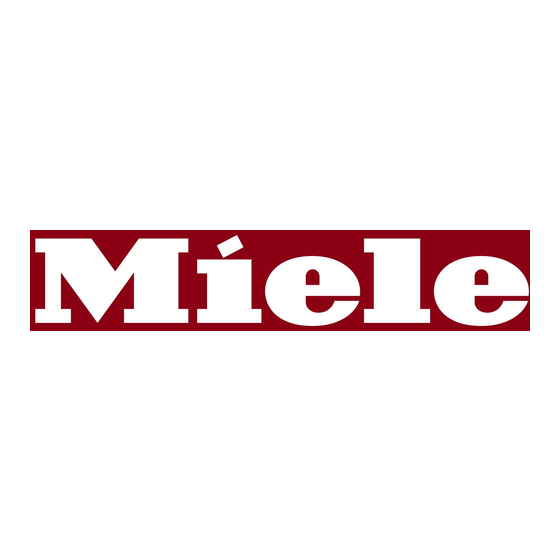Miele PT 7137 WP Vario Plan de instalaciones - Página 10
Navegue en línea o descargue pdf Plan de instalaciones para Secadora Miele PT 7137 WP Vario. Miele PT 7137 WP Vario 11 páginas.
También para Miele PT 7137 WP Vario: Puesta en servicio, organigrama y ajustes (28 páginas)

en - GB
Installation and planning notes
Installation requirements
Electrical connection should only be made to a power supply provided
in accordance with all appropriate local and national legislation and
regulations.
In addition, all regulations issued by the appropriate utilities as well as
standards relating to occupational safety, and all applicable valid
regulations and technical standards must be observed!
General operating conditions
Ambient temperature in installation room: +2°C to +35°C.
Air drawn in for use in the drying process will be warm when it is
expelled back into the room. It is therefore very important to ensure
the room is adequately ventilated, particularly if the dryer is located in
a small room. Air drawn in for use in the drying process will be warm
when it is expelled back into the room. It is therefore very important to
ensure the room is adequately ventilated, particularly if the dryer is
located in a small room.
Make sure that the room temperature is not too high. If there are other
heat producing appliances in the room in which the dryer is located,
make sure the room is well ventilated and switch the other appliances
off, if possible.
Otherwise running times and energy consumption could be increased.
Electrical connection
This machine is fitted with a supply lead and a plug for plug-and-play
operation.
The washer may only be connected to an electrical system that
conforms to the national and local codes and regulations.
The tumble dryer should never be connected by an extension
cable, e.g. power strips, to avoid the risk of fires.
The appliance data plate indicates the nominal power consumption
and the appropriate fuse capacity. Compare the specifications on the
data plate with those of the electrical power supply.
If the machine is hard wired, a dual circuit breaker must be provided
on-site. When switched off there must be an all-pole contact gap of 3
mm in the isolator switch (including switch, fuses and relays according
to IEC/EN 60947).
The plug connectors or isolator switch should be easily accessible for
servicing work. If the machine is disconnected from the electricity
supply ensure adequate measures are taken to ensure that the
machine cannot be reconnected to the electricity supply until all work
has been carried out.
New connections, modifications to the system or servicing of the
ground conductor, including determining the correct fuse amperage,
must be carried out by a qualified electrician, as they are familiar with
the pertinent regulations and the specific requirements of the electric
utility company.
References to cable cross-sections in the technical data refer only to
the required supply lead. Please consult relevant local and national
regulations when calculating any other wire gauges.
Condensate drain hose
The condensed water is pumped away through the drain hose which
is located at the back of the dryer.
The machine drains through a pump with a 1 m delivery head. For the
water to drain freely, the hose must be free of kinks. The swivel elbow
at the end of the hose can be turned in either direction, or removed as
needed with a sharp twist and pull.
In certain situations this tumble dryer must be fitted with a non-return
valve (optional accessory). See "Drain hose connection". There is a
risk of back-flow into the dryer if a non-return valve is not fitted.
Drain hose connection:
1. Direct connection to a plastic drain pipe with a rubber sleeve.
There is no need for a U-pipe. Use a non-return valve if the end of
the hose could possibly become submerged in water.
2. Connected to a sink using a plastic nipple. Always use a non-
return valve.
10
3. Connected securely to a floor drain.
Always use a non-return valve.
4. Direct into a sink or basin If you want to drain the water off
into a sink or basin
The hose should be secured carefully, e.g. by tying it to a tap,
to make sure it cannot slip during use.
Use a non-return valve if the end of the hose could possibly
become submerged in water.
Equipotential bonding
If necessary, equipotential bonding with good galvanic contact must
be guaranteed in compliance with all applicable local and national
installation specifications.
Connection material for equipotential bonding must be provided on
site.
Payment system
This machine can be fitted with a single-machine payment system
(optional accessory). The necessary programming should only be
performed by a qualified agent or by Miele Service.
Serial interface
Depending on the model, a serial interface is either pre-fitted or can
be retrofitted on request.
The serial interface is provided by an additional plug-in XKM RS323
module. The module can only be used on Miele Professional
machines with a communication slot.
Connected external machines must also be fused in accordance with
SELV requirements. External connection units must also comply with
SELV.
The plug-in module is provided with a connection cable and a D-Sub
plug for connection.
Installation and anchoring
The machine must be installed on a perfectly smooth, level and firm
surface which is able to withstand the quoted loads.
The floor load created by the machine is concentrated and transferred
to the installation footprint via the machine feet.
It is not absolutely necessary to bolt the machine to the floor.
The machine should be levelled in both directions with the aid of the
adjustable feet.
The anchors provided can be used to bolt the machine to the floor by
both front feet. The material provided is intended for use in bolting the
machine to a concrete floor.
Bolts and fasteners for all other floor types must be provided on site.
PT 5137/7137
10 145 620 / 01
